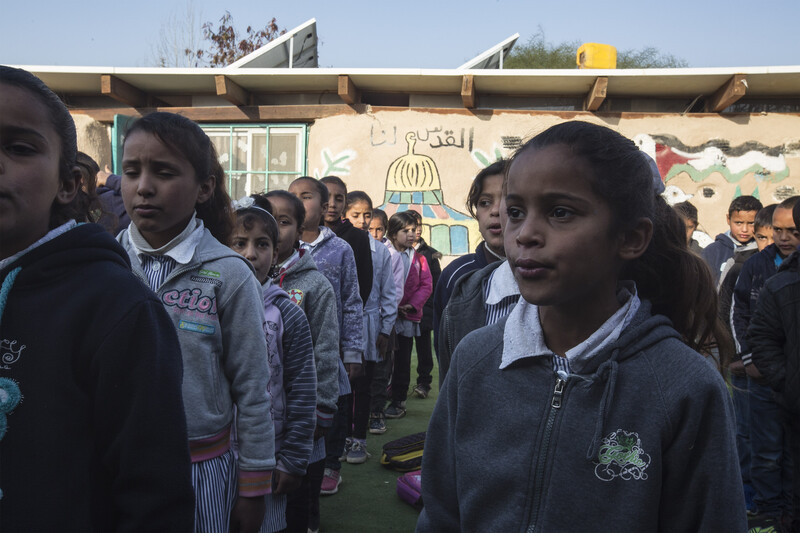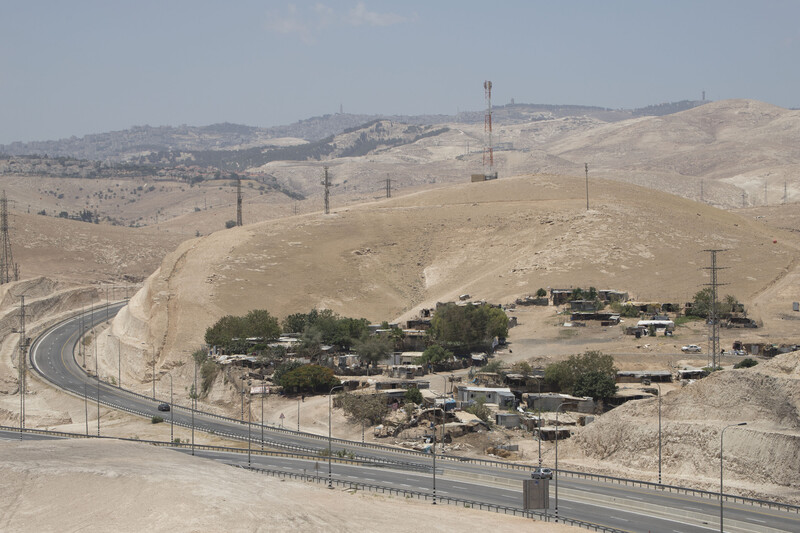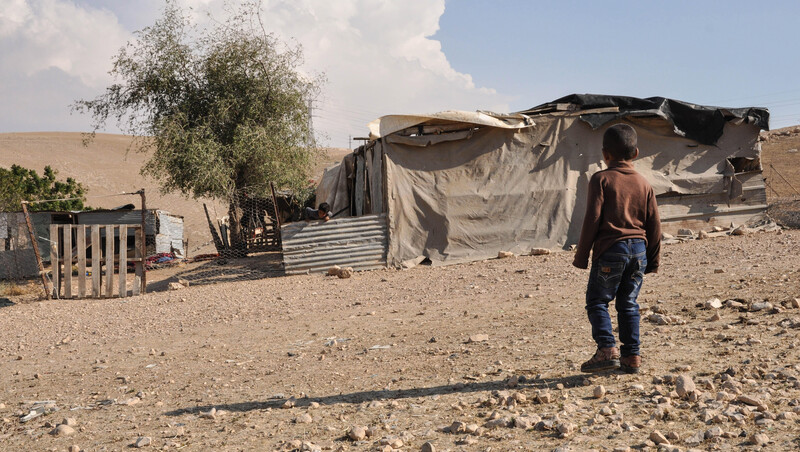The Electronic Intifada 18 June 2018

Settlers in nearby Israeli colonies have petitioned the state to demolish Khan al-Ahmar’s school.
ActiveStillsThe heat pressed down on the sheet metal structures of Khan al-Ahmar. Mistrustful of outsiders, villagers asked that their voices not be recorded when they sat down to discuss the threatened demolition of their village.
Children played near the village school over which a banner in Arabic proclaimed: “We are the Jahalin Bedouin Tribe, don’t demolish our homes that have been here for 50 years!”
On 24 May, an Israeli high court ruling authorized the demolition of the entire occupied West Bank village “any time the government sees fit,” as of June.
Israeli authorities are planning to relocate the Bedouin village’s inhabitants to a location near the garbage dump adjacent to Abu Dis, in the vicinity of Jerusalem. Any such action would require ignoring warnings by rights groups that this sort of forcible transfer amounts to a war crime.
On 11 June, more than 300 public figures from around the world, including parliamentarians, artists, musicians and intellectuals, signed an open letter opposing the transfer and describing it as a war crime.
“They can come any time. We know they will surprise us, at night or in the morning. And they will do it when you are not here to see it,” Nour, 30, who lives in the village, affirmed.
All villagers who spoke to The Electronic Intifada spoke on condition of anonymity and all names have been changed.
Eternally displaced
The Jahalin are part of five Bedouin tribes that were expelled from their ancestral homelands in the Naqab desert during the creation of the state of Israel in 1948. Many of them, like the people of Khan al-Ahmar, fled to the West Bank to settle in the desert along the Jerusalem-Jericho highway.
After Israel occupied the area in 1967, it refused to recognize the Bedouin villages as residential areas.
As a consequence, the community, like all Bedouin communities, has not been linked to water and electricity grids. The Bedouins were also prohibited from building new structures in the village, or from turning their tin shacks into concrete houses.
“You know, we don’t want to live like this,” Nour told The Electronic Intifada. “We want to build concrete houses. We want running water and electricity, and not have rain seeping into our houses at night.”
The village falls in Area C, the 60 percent of the West Bank that is under full Israeli military and administrative control, and where Israel actively develops and expands its settlements, illegal under international law.
Consequently, and over the decades, Khan al-Ahmar became surrounded by the Israeli colonies of Ma’ale Adumim, Kfar Adumim, Nofei Prat and Alon.
Connecting settlements
“I used to live with my family on the hill across from here,” Sara, 56, said, pointing. “But they came and they hit my father and my uncle. My mother had a basin of yogurt. They threw it on the ground.”
After that assault, Sara said she and her family fled to settle in Khan al-Ahmar. The hill she used to live on now belongs to the settlement of Kfar Adumim.
She complains that settlers shoot the sheep when they stray too close and throw stones at the village children.
“But what can we do?” Sara asked. “They have weapons and we don’t. We can’t stop them.”
The community has also been subject to harassment by the Israeli military. “They arrest kids for coming too close to the settlement,” Sara explained. “Just to scare them.”

Israel’s high court ruled in late May that the village of Khan al-Ahmar can be razed “anytime the government sees fit.”
ActiveStillsAs the settlements surround the small village, most of the nearby hills are now off-limits to the Bedouins who need the land to graze their sheep.
“The only way we are allowed to go now is towards the road,” Nour said.
Just days after the high court’s verdict on Khan al-Ahmar’s demolition, Israel announced the building of 92 new housing units for the nearby Kfar Adumim settlement, so close to the village it would almost render it, should it remain, a no-go area.
The land of the village, meanwhile, is also next to an area slated for development under the E1 master plan. That plan aims to create an unbroken developed area connecting East Jerusalem with Ma’ale Adumim, the largest Israeli settlement, effectively cutting off Jerusalem from the rest of the West Bank for Palestinians.
Israel would in effect be expanding its illegal annexation of East Jerusalem to territory further inside the West Bank, making it easier to connect Jerusalem to the Jordan Valley through a corridor of illegal settlements that would divide the West Bank into northern and southern parts.
Struggling for education
Due to the village’s illegal status in Israeli law, the Bedouins have been deprived health care, education and municipal services even as neighboring settlements have flourished, provided with luxurious infrastructure and using extensive amounts of water.
Ma’ale Adumim, for instance, houses “several malls, intra-city transportation, and extensive library, health services, an art museum, sports and recreational facilities, a lake, a music conservatory, parks and more.”
But villagers have fought to improve their lot. With the financial support of an Italian non-governmental organization, Vento Di Terra, they built an elementary school that serves 170 children from the village and four nearby Bedouin communities, some having to travel 15 to 22 kilometers to get an education.
That, however, did not go down well with the neighbors. Since it was finished in 2009, settlers from the nearby colonies have petitioned the state to demolish the school.
Nour is convinced that the Israelis don’t want her community’s children to learn. “We started to read, get smarter,” she told The Electronic Intifada. “That’s why they are demolishing the school. They want Arabs to be ignorant.”
War crime
The Israeli high court has asked the state to provide an alternative location for the Bedouins to live. But human rights groups have warned that forcibly relocating residents of occupied territory constitutes a war crime under international humanitarian law.
The alternate location, known as Jabal West, is wedged between the Palestinian town of al-Eizariya and the former Jerusalem municipal garbage dump near Abu Dis.
Ahmad, 45, said nobody wants to move to this new location, not just because it is being forced upon them, but because it constitutes an unhealthy living environment.
“There is ground water under the garbage dump, the filth seeps into it. Nobody can live there.”
“I only know we would have no space there,” Nour said. “And we would not be able to keep our sheep.”

For decades Israel has prevented villagers from building permanent structures in Khan al-Ahmar.
The Bedouins would have to give up their pastoral lifestyle to adjust to an urban environment.
Nour remains confident they will find a way to stay. The Israeli authorities demolished her house two years ago, she said, and she and her family were forced to sleep under a tree.
“Then we rebuilt our homes,” she said.
“We want a place of our own,” Sara said, dismissing Israel’s plans. “Concrete houses, to be able to travel wherever we want. We will not go to the garbage dump.”
“Even if they demolish our homes, we will stay here.”
Ahmad agrees.
“We were there before them. We are not harming anyone. If they have a problem with us, they should leave.”
Annelies Keuleers is a Belgian journalist based in Jerusalem.





